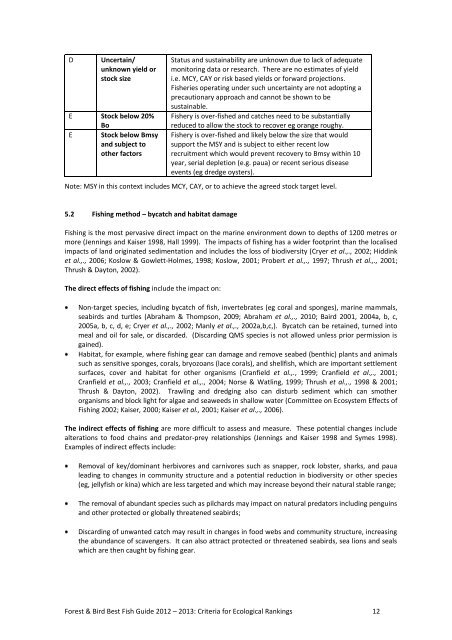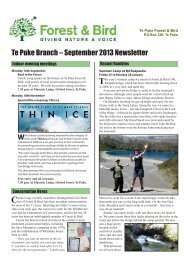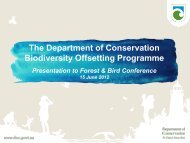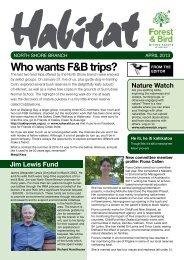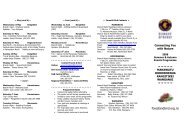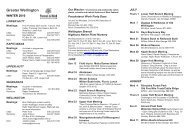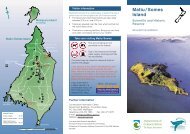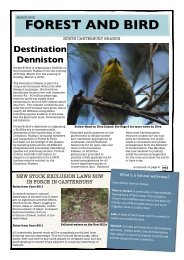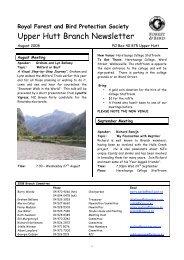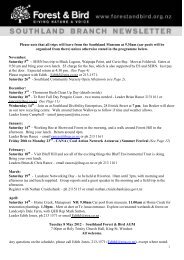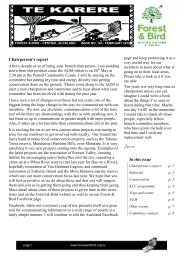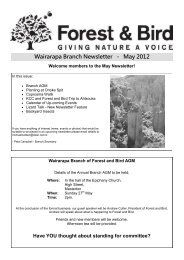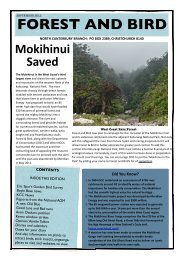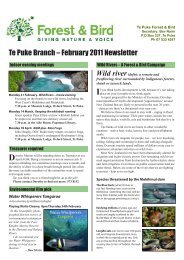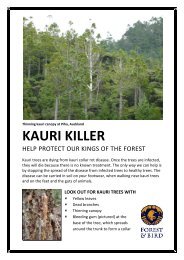methodology - Forest and Bird
methodology - Forest and Bird
methodology - Forest and Bird
You also want an ePaper? Increase the reach of your titles
YUMPU automatically turns print PDFs into web optimized ePapers that Google loves.
D Uncertain/<br />
unknown yield or<br />
stock size<br />
E Stock below 20%<br />
Bo<br />
E Stock below Bmsy<br />
<strong>and</strong> subject to<br />
other factors<br />
Status <strong>and</strong> sustainability are unknown due to lack of adequate<br />
monitoring data or research. There are no estimates of yield<br />
i.e. MCY, CAY or risk based yields or forward projections.<br />
Fisheries operating under such uncertainty are not adopting a<br />
precautionary approach <strong>and</strong> cannot be shown to be<br />
sustainable.<br />
Fishery is over-fished <strong>and</strong> catches need to be substantially<br />
reduced to allow the stock to recover eg orange roughy.<br />
Fishery is over-fished <strong>and</strong> likely below the size that would<br />
support the MSY <strong>and</strong> is subject to either recent low<br />
recruitment which would prevent recovery to Bmsy within 10<br />
year, serial depletion (e.g. paua) or recent serious disease<br />
events (eg dredge oysters).<br />
Note: MSY in this context includes MCY, CAY, or to achieve the agreed stock target level.<br />
5.2 Fishing method – bycatch <strong>and</strong> habitat damage<br />
Fishing is the most pervasive direct impact on the marine environment down to depths of 1200 metres or<br />
more (Jennings <strong>and</strong> Kaiser 1998, Hall 1999). The impacts of fishing has a wider footprint than the localised<br />
impacts of l<strong>and</strong> originated sedimentation <strong>and</strong> includes the loss of biodiversity (Cryer et al.,., 2002; Hiddink<br />
et al.,., 2006; Koslow & Gowlett-Holmes, 1998; Koslow, 2001; Probert et al.,., 1997; Thrush et al.,., 2001;<br />
Thrush & Dayton, 2002).<br />
The direct effects of fishing include the impact on:<br />
Non-target species, including bycatch of fish, invertebrates (eg coral <strong>and</strong> sponges), marine mammals,<br />
seabirds <strong>and</strong> turtles (Abraham & Thompson, 2009; Abraham et al.,., 2010; Baird 2001, 2004a, b, c,<br />
2005a, b, c, d, e; Cryer et al.,., 2002; Manly et al.,., 2002a,b,c,). Bycatch can be retained, turned into<br />
meal <strong>and</strong> oil for sale, or discarded. (Discarding QMS species is not allowed unless prior permission is<br />
gained).<br />
Habitat, for example, where fishing gear can damage <strong>and</strong> remove seabed (benthic) plants <strong>and</strong> animals<br />
such as sensitive sponges, corals, bryozoans (lace corals), <strong>and</strong> shellfish, which are important settlement<br />
surfaces, cover <strong>and</strong> habitat for other organisms (Cranfield et al.,., 1999; Cranfield et al.,., 2001;<br />
Cranfield et al.,., 2003; Cranfield et al.,., 2004; Norse & Watling, 1999; Thrush et al.,., 1998 & 2001;<br />
Thrush & Dayton, 2002). Trawling <strong>and</strong> dredging also can disturb sediment which can smother<br />
organisms <strong>and</strong> block light for algae <strong>and</strong> seaweeds in shallow water (Committee on Ecosystem Effects of<br />
Fishing 2002; Kaiser, 2000; Kaiser et al., 2001; Kaiser et al.,., 2006).<br />
The indirect effects of fishing are more difficult to assess <strong>and</strong> measure. These potential changes include<br />
alterations to food chains <strong>and</strong> predator-prey relationships (Jennings <strong>and</strong> Kaiser 1998 <strong>and</strong> Symes 1998).<br />
Examples of indirect effects include:<br />
Removal of key/dominant herbivores <strong>and</strong> carnivores such as snapper, rock lobster, sharks, <strong>and</strong> paua<br />
leading to changes in community structure <strong>and</strong> a potential reduction in biodiversity or other species<br />
(eg, jellyfish or kina) which are less targeted <strong>and</strong> which may increase beyond their natural stable range;<br />
The removal of abundant species such as pilchards may impact on natural predators including penguins<br />
<strong>and</strong> other protected or globally threatened seabirds;<br />
Discarding of unwanted catch may result in changes in food webs <strong>and</strong> community structure, increasing<br />
the abundance of scavengers. It can also attract protected or threatened seabirds, sea lions <strong>and</strong> seals<br />
which are then caught by fishing gear.<br />
<strong>Forest</strong> & <strong>Bird</strong> Best Fish Guide 2012 – 2013: Criteria for Ecological Rankings 12


